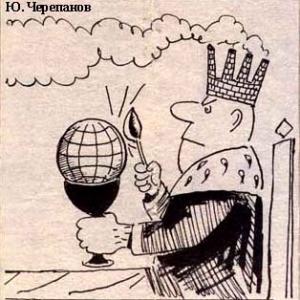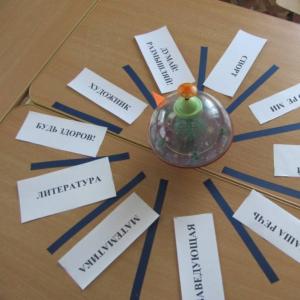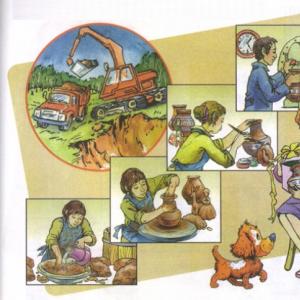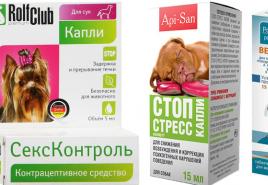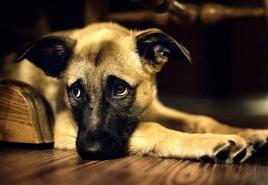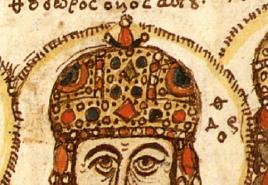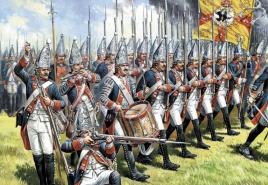What is it made of? — Hypermarket of knowledge.
Open menu
Subject “The world around us”
Summary of an open lesson on the topic “What is what made of?” 2nd grade 04.12.2015 Federal State Educational Standard, Educational and Cultural Center "School of Russia" Lapina A.A. Teacher
MBOU "Secondary School No. 37" Bratsk
Teacher's goals Target.
Introduce the natural materials from which various objects are made; to form basic ideas about some production processes, starting with the extraction of raw materials in nature and ending with the receipt of the finished product; cultivate a caring attitude towards natural resources.
Tasks.
Educational:
Introduce natural materials used in the manufacture of various items; ;
Introduce the simplest production chains in the manufacture of various items
Formation of ideas about the surrounding world.
Educational:
Develop mental operations: synthesis, analysis, generalization;
Develop the ability to work in a group, in pairs.
Educational:
Cultivate interest in the subject through understanding the interaction between man and nature.
Foster a sense of camaraderie, accuracy, perseverance.
Lesson type
Setting and solving an educational problem
Planned
educational results Subject
(scope of development and level of competence): Learn to: build
the simplest production chains for the manufacture of various items will have the opportunity to learn:
find information (text, graphic, visual) in a textbook, analyze its content. :
Metasubject educational –
- independently identify and formulate a cognitive goal,
Set up a search problem;
Conduct analysis and synthesis when getting acquainted with sectors of the economy;
Apply information retrieval methods (using computer tools);
Conduct reflection on performance results;
evaluate your achievements, answer questions, relate learned concepts with examples; communicative –
-listen and engage in dialogue;
Participate in collective (group) discussion of problems;
Manage the behavior of group members, adjust and evaluate their actions;
be able to listen to the interlocutor and conduct a dialogue, master the dialogical form of speech, engage in verbal communication;
regulatory
Set a learning task based on the correlation of known and learned material;
organize your workplace under the guidance of a teacher, master the ability to understand the educational task of the lesson and strive to fulfill it.
Personal:
Orientation in interpersonal relationships when working in a group;
Acceptance and mastery of the social role of the student;
Development of motives for educational activities, skills of cooperation with adults and peers in different social situations;
Formation of personal meaning of teaching
Methods and forms of training
Methods and methodological techniques: explanatory and illustrative; verbal, visual, partially search, practical, game.
Forms of work: frontal, group, individual.
Educational Resources
UMK "School of Russia": - Pleshakov A.A. "The world". Textbook for 2nd grade. Part 1. M.. Enlightenment, 2012.,
- Workbook for 2nd grade. Part 1. M.. Enlightenment, 2012.,
Test book for grade 2 M.. Education, 2012.
Presentation;
Cards – tests for individual questioning;
During the classes
Stage name, goal
Teacher activities
Student activity
UUD
1.Org. stage.
Good afternoon guys!
The bell has already rung.
The lesson begins.
We are not alone today
The guests have arrived for the lesson.
Turn around quickly
Greet your guests!
Guys! Repeat after me.
I know how to think and understand, I know how to listen and respond,
I could be wrong,
I know how to study
I want to learn. (slide 1)
Let the motto of our lesson be the words: “You know it yourself - tell someone else!” ()
slide 1
We will continue our journey into the world of knowledge. I hope that our communication today will bring you new knowledge, and, therefore, new joys.
Greetings from the teachers. Organize their workplace, check the availability of individual educational supplies on the table
They greet each other. Regulatory:
anticipation of the result and level of knowledge assimilation, awareness of what has already been learned and what needs to be learned, awareness of the quality and level of assimilation. Personal
2. : knowledge of basic moral norms, awareness of oneself as a member of society; educational and cognitive interest in new educational material.
Checking homework
What section are we studying?
(slide2)
What is economics?
What are the parts of the economy called?
What industries does the economy consist of?
Let's remember what professions we called?
Name your parents' professions. Let's test your knowledge with tests (Test book for 2nd grade M.. Education, 2015).
(slide 3)
What is it that a modern economy cannot function without?
What do you know about them?
City and village life"
This is the economic activity of people.
- Industry, transport, agriculture, trade, construction.
Milkmaid, shepherd, driver...
Children name their parents' professions and say which sector of the economy it belongs to.
Perform a test, mutual check
- Without money
The child introduces the children to his mini-project “How money appeared”
Regulatory
anticipation of the result and level of knowledge assimilation, awareness of what has already been learned and what needs to be learned, awareness of the quality and level of assimilation.: Anticipation of the result and level of knowledge assimilation, awareness of what has already been learned and what needs to be learned, awareness of the quality and level of assimilation, evaluation of the result
Communication
3. Self-determination in activity
Tasks: develop logical thinking, interest in new research,
Name the objects you see on the slide. (slide 4)
Determine which item is “extra”?
Why?
What is the name of something made by human hands?
Socks, mittens, books, pots, fork, kettle, jug, shell.
The shell was created by nature, and the rest was made by man.
Man-made world.
Regulatory: volitional self-regulation, structuring of knowledge, analysis of objects in order to identify features, selection of grounds and criteria for classifying objects
anticipation of the result and level of knowledge assimilation, awareness of what has already been learned and what needs to be learned, awareness of the quality and level of assimilation.: Anticipation of the result and level of knowledge acquisition, awareness of what has already been learned and what needs to be learned, awareness of the quality and level of assimilation, evaluation of the result
Communication: planning educational cooperation with the teacher and with peers.
4.Updating knowledge,
1)statement of the problem.
2) Determining the topic and objectives of the lesson
I suggest you think about what the person made these objects from.
Guess what we will talk about in class?
Formulate the topic of the lesson. (slide 5)
What goals and objectives will we set for ourselves? Use our phrase for this:
I think I'll find out..... (slide 6)
Let's open the textbook on page 108 and read the topic of the lesson again, which we will learn about in class .(slide 7)
What seems difficult and still unclear?
To do this, we will learn to think, reflect, reason, understand the meaning of what we hear and read, and also draw some conclusions for ourselves. What can help us with this?
Made of metal, made of wool,
From paper, from clay...
Let's find out what and how people make different products from.
What is it made of?
Working with the textbook p.108
What does it mean to depict production chains?
Textbook, additional literature, Internet, adults.
They greet each other. the ability to determine the purpose of the lesson, navigate the textbook, carry out analysis and classification according to given criteria; act according to the planned plan, as well as according to the instructions contained in the sources of information: the teacher’s speech, the textbook.
Communicative:
Personal: a broad motivational basis for educational activities, including social, educational, cognitive and external motives;
Cognitive: independently find the necessary information in the textbook materials, in the required educational literature, carry out analysis, synthesis, comparison, classification of language material according to given criteria
5.New material.
1) Fixing an individual difficulty in a trial action.
Goal: To prepare students for the discovery of new knowledge, to perform a trial learning activity and to record individual difficulties. 2) Identifying the location and cause of the difficulty.
Goal: Restore completed operations and record the place - step where the difficulty arose.
3) Constructing a project for getting out of the difficulty
Purpose: setting the goal of the lesson and
choosing a way to solve a learning problem,
4) Implementation of the constructed project.
Goal: students put forward hypotheses and build models of the original problem situation.
Since ancient times, people have had to adapt to living conditions in different environments. The tools, dwellings and household items created by people, clothing, and jewelry were made from the materials that were available in that area.
- The most ancient are stone tools. Ancient people first used fragments of stones, branches and tree limbs. Scientists believe that the very first tool made by ancient man was a hand ax carved from stone.
Nowadays, from birth, a person enters the world of things. We are already so accustomed to this that we don’t think about how and from what the objects around us are made. (slide 8)
-Work in a group Exercise: Take the cards on your desks. Divide all items into groups and explain your choice. (slide 9)
- made of clay (teapot, vase),
- made of wool (sweater, scarf),
- made of metal (spoon, pan),
-made of wood (ruler, cabinet, notebook and book) Let’s check. (slide 10)
All these items are familiar to you. Tell me again, what do all these items have in common?
Let's now trace the manufacturing path of some products. Today in this work I will have assistants who will share their research on this topic.
1. Guess the riddle: (slide 11)
If you meet me on the road,
Your feet will get stuck,
And make a bowl or vase-
You'll need it right away.
Look at these items: dry clay and a clay cup. How do you get such durable cookware?
Alice has done a little research and will now tell you how objects are made from clay. (slide 12-18)
Can we make such dishes?
Why?
Alice introduced us to the procedure for making clay products.
The order in which an item is manufactured is called the production chain. (slide 19)
Open your notebook and show the sequence of making clay dishes . (work in pairs) (slide 20)
Quarry - potter's wheel - oven - cup.(slide 21)
- Look at the screen, I suggest you look again at how clay products are made. (slide 22)
FISMINUTKA (slide 23)
2. Let's continue working(slide 24)
Well done every year
Adds around the ring.
Even ancient people made weapons and tools from wood. What people did from wood! From a home for yourself to toys for children. And now folk art is simply unthinkable without wood products. It’s probably easier to ask: what can’t be made from wood?
- It is clear that the ruler and cabinet are made of wood. But how did the book and notebook end up in this group? (slide 25)
Diana has done research and will now tell you how books are made. (slide 26-31)
In our city there are recycling collection points where waste paper is accepted. Don’t throw away paper, collect it and take it to such points and you will save trees from being cut down.
- We work in pairs. Fill out the diagram in your notebook. - How is a book made from wood? (slide 32)
Wood - pulp - paper - book.
(slide 33)
- Look at the screen, I suggest you look again at how paper is produced (slide 34)
3. - In the next group we have objects made of metal. (slide 35)
My assistant Roman also conducted research and will now tell you how metal objects are made. (slide 36-41)
Let's create a production chain. - How do metal utensils come into our home? (slide 42)
Iron ore - cast iron - steel - cookware
- Look at the screen, I suggest watching an excerpt from the film, how objects are made from steel (slide 43)
4. Wool.
– Man has always taken care of his domestic animals, and they provided people with food and warmth. (slide 44)
Thick grasses entwined,
The meadows are curled up,
And I myself am all curly,
Even a curl of a horn. (Sheep, ram)
How are warm mittens, a sweater and sheep connected? (slide 44)
So, we move on to the last group we selected, “Wool Products” (slide 45)
Open your textbook. Look at the pictures (p. 111) and tell us how woolen things are made .(slide 46)
1. Sheep shearing;
2. Making wool yarn, winding into bobbins;
3. Manufacturing of woolen fabric;
4. Manufacturing of clothing parts according to patterns.
Show in your notebook the sequence of making things from wool. ( pair work)(slide 47)
Sheep-yarn-fabric-product.
- There are other animals that are bred for wool - camels, Angora rabbits and goats, llamas, vicunas, musk oxen and even dogs. (slide 48)
Divide objects into groups and explain their version of dividing objects into groups according to a certain criterion
They are made by human hands.
Clay
children's answers
No
We need the knowledge and work of many people.
Notebook p. 70
Watching a movie
Tree
children's answers
Student message (see appendix).
Notebook p. 70
Watching a movie
Student message (see appendix).
We work collectively
Watching a movie
– In spring and autumn, people shear sheep with special scissors. Then they spin the wool and knit socks and mittens.
Children tell stories based on pictures in the textbook p.111
They greet each other. the ability to determine the purpose of the lesson, navigate the textbook, act according to the plan, take into account the rule in planning a solution, the ability to work according to the plan, control the process and results of one’s activities.
Communicative: participate in dialogue, in general conversation, following the accepted rules of speech behavior, draw up small oral monologues, “holding” the logic of the narrative.
Cognitive: independently find the necessary information in the textbook materials, in the required educational literature; construct messages in oral and written form.
Personal: educational and cognitive interest in new educational material;
The ability to self-assess based on the criterion of success in educational activities.
6. Application of acquired knowledge through the creation of a problem situation.
Independent work with self-test according to the standard. Target: independently complete tasks of a new type, carry out self-testing, step by step comparing them with the standard, identify and correct possible errors.
So, we have become acquainted with some materials from which a person can make the objects he needs.
Group work according to the “Workbook” p.79 No. 2,3 (slide 49)
-No. 2 Write what people can turn these materials into.
-No. 3. Create production chains (slide 50)
clay- bricks, clay toys, vases, dishes
wool– mittens, sweater, carpets, scarf. hat.....
wood - furniture, paper, books, cardboard, houses, bridges......
iron ore-plant-scissors;
h erno-mill-flour-bread
clay- pottery wheel - oven - vase
……..
Communicative: enter into educational collaboration with classmates, participate in joint activities; ask questions, answer questions from others; evaluate the thoughts, advice, suggestions of other people, take them into account.
Cognitive: independently find the necessary information in the textbook materials, in the required educational literature; construct messages verbally and in writing make a simple plan.
They greet each other. plan (in collaboration with the teacher, independently, with classmates) your actions to solve the problem; act according to plan; transform a practical task into a cognitive one. Evaluate your achievements. Structuring knowledge, analyzing objects to identify features, choosing bases and criteria for classifying objects, consciously constructing an oral statement
8. Physical education break
Perform movements according to the text under the guidance of the teacher. Prevents fatigue. Focus on a healthy lifestyle
9. Lesson summary.
– Where do people get materials to make various products?
What should people pay attention to when extracting various materials from nature to make all kinds of products?
(slide 51)
– A person must use resources wisely. Natural resources must be protected, because they are not limitless.
(slide 52)
By making paper, people cut down forests, and they are “the lungs of our planet,” a home for animals and birds. After the extraction of clay, there are quarries left that must be filled up, otherwise there is a wound on the surface of the earth. And if a person uses natural resources unwisely, then what can this lead to?
Guys, remember that the knowledge and work of many people is invested in every thing, so you need to treat things with care. (slide 53)
I did a great job in class and enjoyed it!
I did a good job, but next time I will be even more active.
I'm not happy with my performance in this lesson, but I'll definitely do better next time! (slide 54)
In nature.
1) Extract no more materials than are required.
2) Spend sparingly.
3) Plant new trees.
4) Restore land at the site of quarries.
Openly reflect on and evaluate their activities in the classroom
Communicative: enter into educational cooperation with classmates, participate in joint activities, provide mutual assistance, exercise mutual control, and show a friendly attitude towards partners.
10. Reflection educational activities in the classroom.
Target: Record new content learned in the lesson and organize reflection and self-evaluation by students of their own learning activities
Reflection. Continue the sentence: - It was interesting to find out that...
I was surprised... - It was difficult...
Now I know that …(slide 55)
They greet each other. record new content learned in the lesson and organize reflection and self-evaluation by students of their own learning activities plan (in collaboration with the teacher, independently, with classmates) their actions to solve future problems.
11. Homework.
pp. 108-111, workbook p. 70 No. 3, No. 4 (slide 56) , (slide 57)
Listen to the teacher's explanation. Make appropriate notes. Accept learning tasks in accordance with their level of development
They greet each other. act according to plan; transform a practical task into a cognitive one. Evaluate your achievements. Cognitive: independently find the necessary information in the textbook materials, in the required educational literature, carry out analysis, synthesis, comparison, classification of language material according to given criteria.
Target: Introduce the natural materials from which various objects are made; to form basic ideas about some production processes, starting with the extraction of raw materials in nature and ending with the receipt of the finished product; cultivate a caring attitude towards natural resources.
Planned results: find information (text, graphic, visual) in a textbook, analyze its content.
Regulatory: be able to formulate learning task; understand the learning task of the lesson and strive to complete it ; formulate conclusions from the studied material; answer final questions; realize control and correction; evaluate results of your activities in the lesson. Cognitive:classify objects by the nature of the material, show different production chains in color; read textbook text; according to textbook drawings trace production chains, model them, make up story based on pictures, give other examples of the use of natural materials for the production of products. Communicative: participate in pair and group work. Agree with each other, accept the interlocutor’s position, show respect for other people’s opinions.
Subject: learn what natural materials people use to make products; learn to create simple production chains
Personal: take care of things; understand the need to respect nature; respect people's work.
Educational materials: Textbook by A.A. Pleshakov “The World Around us”, workbook No. 1, computer, multimedia projector, screen, various objects made of clay, metal, wood, wool; cards - models. U students: signal flags, colored pencils (markers)
1. Organizational moment, emotional mood. (slide1)
The cheerful bell rang
Is everyone ready? All is ready?
We are not resting now,
We are starting to work.
2. Checking homework.
A) Individual tasks using cards. (2 children receive tasks)
Emphasize industrial products with one line and agricultural products with two.
1. Tomato, book, carrot, telephone, table lamp, potato, tractor, radish, onion, chair, iron, slippers.
2. Watermelon, cherry, chair, T-shirt, grapes, boots, coat, rocket, plum, school desk, pumpkin, cabbage, airplane, garlic, cucumber.
B) Game “True or False.”
Let's play the game “Is this true or false” (working with traffic light cards: if true, green, if not, red)
Is it true that the economy is the economic activity of people? (Yes)
Is it true that trade gives us bread, milk, and meat? (No)
Is it true that paper money was first used in China? (Yes)
Is it true that money is not made from wood these days? (Yes)
Is it true that clothes, shoes, furniture are produced in trade? (No)
Is it true that a painter, mason, plasterer, and crane operator work in construction? (Yes)
Is it true that we can purchase products and things from agriculture? (No)
Is it true that in order for us to drink a glass of milk in the morning, only agriculture and trade are working? (no, transport, industry)
Is it true that transport and industry specialists participate in the construction of a house along with the builders? (Yes)
Is it true that all sectors of the economy are connected to each other? (Yes)
Self-determination for activity
Look at the screen . (slide 2) The slide shows different objects.
(Shell, mittens, scissors, jug, ruler, spoon, scarf, mug, pencil)
Determine which one is “extra”? (shell)
Why? ( The shell was created by nature, and the rest was made by man)
What is the name of something made by human hands? ( Man-made world)
Practical work.
Divide the remaining items into groups based on material. (Divide objects into groups.)
All these items are familiar to you. Name them and explain what they do. What do all these items from the same group have in common? (Name the objects. Tell what they are for - made of clay (vase, pot, brick, clay whistle toy),
Made of wool (sweater, gloves, socks, scarf),
Made of metal (spoon, bowl, mug, scissors, metal construction set),
Made of wood (ruler, wooden spoon, nesting doll, notebook).
What will we talk about in class? (We will find out what and how people make different products from.)
Read the topic of the lesson in the textbook.
Formulate the educational tasks that we will set for ourselves? (we will talk about objects, find out what they are made of). Let's read about this in the textbook.
Working on the topic of the lesson.
Conversation “What is what?” (Work in groups)
Now let's talk about each group of items separately.
1. Wool (consider a group of wool items ) (slide 3)
We have determined that these items are made of wool. Where does wool come from?
(p. 111 of the textbook) Look at the pictures and tell us how woolen things are made.
1. Sheep shearing;
2. Making wool yarn, winding into bobbins;
3. Manufacturing of woolen fabric;
4. Drawing on fabric;
5. Manufacturing of clothing parts using patterns.
What new things have you learned about wool making?
How did you make this scarf? How did you get the different colors?
2. Tree (consider a group of wooden objects) (slide 4)
It is clear that the ruler and stand are made of wood. But how did the notebook end up in this group? How did our textbooks come into being? The guys who prepared the messages will help us figure this out.
a) Student speeches about paper making.
There are different types of paper. Where is it used?
The mill produces paper.
- The writer writes a work.
- Artist makes illustrations
- The publishing house prints books.
- Books appear in the store.
Children's performance.
Today, paper is made in factories where machines help people.
Machines get to work even when the future paper is growing in the forest. Electric saws cut and fell trees. Timber tractors carry logs to the river. Machines tie the logs into rafts, and the rafts float along the river to the workshop gate. Then other machines take over: a fast multi-saw machine cuts logs into logs; a debarking machine removes the bark from them; a chipper cuts logs into chips; the chips travel on a self-propelled track into the boiler. Wooden porridge is cooked in a special solution in a cauldron. When this porridge is ready, it becomes paper.
b) Showing a collection of different types of paper.
What is paper used for?
Is it easy to get the paper? How should we treat our notebooks and textbooks, because these are all cut down trees? And to grow an adult tree it takes at least 60 years.
They also make furniture, dishes, and toys from wood. (Show.)
6. Physical exercise
Now guess who we are talking about?.( The music sounds “Bu-ra-ti-no!”)(slide5)
Why do you think we remembered Pinocchio? (made of wood)
And from which fairy tale? (“Golden Key”. A. Tolstoy)
7. Conversation “Which is which?” (continuation)
For a long time in Rus', dishes and such wonderful toys were made from clay. (slide 6)
And how toys are made from clay, we learn from a fragment of the film .
(View a fragment of the film “The Inheritance of Grandfather Philemon.”)
A student's story about clay.
Clay is extracted from the quarry using excavators. In its raw form it is plastic. It is mixed with water to form a thick paste and then used to make dishes or toys. When the clay dries, it hardens and becomes very strong. The products are then fired in a kiln at a high temperature of 450°C. After firing, the clay becomes strong and will never become soft. The art of doing such things is called ceramics.
In ancient times, when there were no refrigerators, clay jugs were used to store cold water. The water remained cold as it seeped through the thin pores of the jug and evaporated, which helped keep the water cold.
The Chinese were wonderful potters. Made from special white clay porcelain. When fired, this clay becomes white. This cup is also made of clay.
It must be said that bricks, toys, and tiles are made from clay.
In the last group we had objects made of metal . (slide 7)
Student's story about iron production
Nobody makes iron, it is created by nature itself, like water, clay, sand... And people only mine this iron and turn it into cast iron and steel.
Iron is visible and invisible in the world - it is in sand (that’s why it is yellowish), and in reddish-brown clay, and in brown stone - flint. Iron is even dissolved in water.
Iron ores contain the most iron. It is from them that this most important metal is mined.
How is ore mined?
Here you can’t do without a huge, powerful steel digger, a small paper bag with an explosive charge and long wires. Miners will drill holes in the ground, place explosives in them, and send current through the wires. Shut your ears here. As soon as the explosion thunders, tons of earth and stones will fly into the air, scatter around, and the ore hidden underneath will be revealed. It happens that the ore itself has to be crushed by explosions. Finally, the explosions died down. A walking excavator gets to work. The excavator will scoop up ore with a scoop bucket, turn around, and a whole wagon or giant dump truck will be loaded. But the ore was brought to the plant. How to turn it into iron? A hot fire helps people here. In huge furnaces, blast furnaces, like high-rise buildings, flames rage day and night. Here, to the very top of one of these domains, trolleys crawled along an inclined road. They will rise, tip over, pour the load into the oven - and down. Some trolleys contain ore, others contain white stone and limestone, and others contain fuel, dark gray spongy coke. It is like a pie, baked from the best coal ground into flour. Well, limestone helps the coke to draw out all the excess impurities from the ore.
Coke burns hot, but it cannot melt ore. To make it burn even hotter, you need to constantly fan the fire, you need air, hot, red-hot. That is why there are several more towers next to the blast furnace. It is in them that the air heats up. Powerful fans drive air currents through the pipes, continuously fanning a firestorm in the blast furnaces. The flame rages, the ore melts, settles, drops of cast iron metal gather in streams, streams... Cast iron is heavy, it flows to the bottom of the furnace, and all the excess that was in the ore rises and floats up in a bubbly fiery foam. This is slag.
Finally the master gives a signal: “The cast iron is ready!” We can release the melt.” A minute, another... and, scattering fountains of sparks, illuminating the sky with a fiery glow, liquid metal pours into a huge ladle. There are many buckets, each on wheels. There is a whole cast iron train standing on the rails. Once one ladle is filled, the next one will immediately fit under the stream. Where will the fire-breathing train go? His path is not far - to the neighboring workshop. Here the cast iron will be poured into molds. In them, the liquid metal will solidify and take the shape of the very mold into which it was poured. And you and I encounter cast iron every day. After all, ordinary frying pans, cast iron pots, radiators, grates into which streams run in the streets - all this is also cast from cast iron.
So, we have become acquainted with some materials from which a person can make the objects he needs. Now, to consolidate, let’s do the tasks in the notebook.
Consolidation (work in pairs):
Independent work using the “Workbook” pp. 39-40 No. 1,2
Show different production chains with arrows of different colors.
Write down what people can turn these materials into.
(Grain, mill, bread. Iron ore, factory, scissors, etc.)
And besides clay, wood, metal, what materials can various objects be made from? (Plastic, rubber, glass, etc.)
What should people pay attention to when extracting various materials from nature to make all kinds of products?
1) Extract no more materials than are required.
2) Spend sparingly.
3) Plant new trees.
4) Restore land at the site of quarries.
8. Lesson summary: (slide 8)
What question was answered in class?
Who now knows what dishes, clothes, and comfortable things can be made from?
To make various things, people mainly use materials found in nature. But their supply is not unlimited. Therefore, a person must treat natural resources with care.
9. Reflection (slide 9)
- I know that …
- I learned …
- I am satisfied…
10. Homework (slide 10)
>> What is it made from?
There are many objects made by human hands around us. To make them, natural materials are needed: clay, metals, wood, limestone, granite and others.
What items do you need wood to make? Cover them with green chips.
Cover metal objects with red chips.
What is made of clay? Cover with yellow chips.
Cover woolen items with blue chips.
In order for natural materials to turn into various things, we need knowledge and a lot of people's work. This is how clay is turned into a variety of products.

Based on the drawings, tell us how vases, jugs and other objects are made from clay.
What other materials do people take from wildlife?
What are these materials made from?
Seryozha and Nadya’s dad drew pictures for many books. He knows how a book is born and wants to tell you about it. But tell it not in words, but with the help of drawings.

Using these pictures, make up a story about how a book is made.
What other materials do people get from plants? What are these materials made of?
Using drawings, write a story about how woolen items are made.

What else do people get from animals?
Let's look at the buffet where the dishes are. Here is your favorite cup - bright, colorful, with flowers and patterns. Here is a cup from my mother and grandmother. All this is made from ordinary clay. Even more surprising is that the saucers, the sugar bowl, and the thin, white, almost transparent porcelain cups of the most beautiful set are also made of clay. Although they don't look like clay at all.
If you live in a village, then, of course, more than once you have seen krinks in which milk is stored in the cellar, or pots in which cabbage soup is cooked in the stove. Both pots and bowls are also made of clay. And the oven itself!
Many large houses in the city are made of bricks. But bricks are also made from clay at a brick factory. Even the thick walls and high towers of the Moscow Kremlin are also made of clay bricks!
Yu. Arakcheev, L. Khailov


The birthplace of paper, without which we cannot imagine our lives today, is Ancient China. At first, the Chinese wrote and drew on silk or bamboo tablets.
The first paper was made almost two thousand years ago from tree bark and old fishing gear. In ancient China, paper pulp was boiled in special ovens. Then sheets of paper were pressed. After thorough drying, the paper sheets were ready for writing.
Nowadays paper is made from wood. And also from old paper, newspapers - waste paper. By handing it over for recycling, we save forests with greenery.
According to G. Kublitsky
Come up with questions for these stories.
Pleshakov A. A., The world around us, Proc. for 2 classes beginning school B 2 Part 1 / A. A. Pleshakov. - 7th ed. - M. Education, 2006. - 143 p.; ill.
Calendar and thematic planning in natural history, tasks and answers for schoolchildren online, courses for teachers in natural history download
Lesson content lesson notes supporting frame lesson presentation acceleration methods interactive technologies Practice tasks and exercises self-test workshops, trainings, cases, quests homework discussion questions rhetorical questions from students Illustrations audio, video clips and multimedia photographs, pictures, graphics, tables, diagrams, humor, anecdotes, jokes, comics, parables, sayings, crosswords, quotes Add-ons abstracts articles tricks for the curious cribs textbooks basic and additional dictionary of terms other Improving textbooks and lessonscorrecting errors in the textbook updating a fragment in a textbook, elements of innovation in the lesson, replacing outdated knowledge with new ones Only for teachers perfect lessons calendar plan for the year; methodological recommendations; discussion program Integrated Lessons
: knowledge of basic moral norms, awareness of oneself as a member of society; educational and cognitive interest in new educational material.
- What is economics?
- What are the parts of the economy called?
- What industries does the economy consist of?
- Are different parts of the economy connected to each other?
- Let's test your knowledge (take the test)
At this time, several students complete the test in Excel on the computer.

Test on the topic " What is economics?
1 . Complete the definition: “Economics is...”
a) caring for nature
b) the opportunity to earn money
c) human economic activity
2. Which sector of the economy gives us bread, milk, meat?
a) industry
b) agriculture
c) trade
3 . Which sector of the economy produces clothes, shoes, furniture?
a) industry
b) agriculture
c) trade
4. What sector of the economy helps us purchase products and things?
a) industry
b) agriculture
c) trade
5. Which sector of the economy delivers food and goods?
a) trade
b) transport
c) construction
6. Which sector of the economy constructs various buildings?
a) trade
b) transport
c) construction

All this is made by human hands from natural
materials - wood, metal, wool. But
so that natural materials become
in a variety of things, you need knowledge and great
people's labor.
How is a book born?
How are woolen items made?
Where do spoons, forks and knives come from?

Nowadays, from birth, a person enters the world of things. We are already so accustomed to this that we don’t think about how and from what the objects around us are made.

Game "Living - Nonliving." Images of inanimate objects are displayed on the interactive board.
Distribute items into groups so that in each group all items are made of the same material

Clay
If you meet one on the road, Your feet will get very stuck, And to make a bowl or vase, You will need it right away.

The “skillful hands” of a potter can sculpt various objects from it
How did the clay jug appear?
Clay is extracted using excavators...
Products are fired in a special oven

And now everything is ready!
The art of doing such things is called
ceramics

Porcelain was first produced in 620 in China. It was made from white clay. But the Chinese achieved especially great success in this matter quite recently, in the 15th century, under the emperors of the Ming dynasty.
Chinese porcelain. XV century.

Making a chain
Potter's wheel
quarry production


Where does iron come from?
No one makes iron, it is created by nature itself, like water, clay, sand... And people only mine it and turn it into cast iron or steel.
Iron ore contains the most iron.

How is ore mined?
The explosion crushes the earth and stones, revealing the ore hidden underneath them
A walking excavator gets to work.
He scoops up ore with a ladle, turns around, and a whole dump truck is loaded!

The ore enters the plant...
Hot fire helps people here
The fire rages, ore settles, drops of metal gather in streams, streams... the result is cast iron
Iron ore is fed into huge furnaces...
Now his way to the next workshop




The metal will be poured into molds and left to harden.
And here is the result!

Where did the paper come from to make notebooks and books?

Making a chain
Iron ore

Where did the paper come from to make notebooks and books?
Today, paper is made in huge paper mills, where machines help people with everything. Machines come to the rescue when future paper grows in the forest.


Logs float along the river or their
transported in special carriages. And here other machines take over: the gang saw
saws the logs into logs, and the debarking machine strips the bark from them.




Making a chain
cellulose

Wool
Thick grasses entwined,
The meadows are curled up,
And I myself am all curly,
Even with a curl of the horn

Grooming Combing Washing wool
Drying Making yarn from wool

Making a chain

Now tell me yourself...
… how the bread came to the table

Lesson summary
Where does a person get materials to make various items?
What should people pay attention to when extracting various materials from nature?

Conclusion:
By extracting various materials, people change nature, often causing harm to it. The quarry left over from clay mining is a wound on the surface of the earth. A deforested forest is the destroyed “home” of many plants and animals. That is why natural resources must be protected - because they are not limitless.
You also need to remember that the knowledge and work of many people are invested in every thing, so you need to treat things with care!

